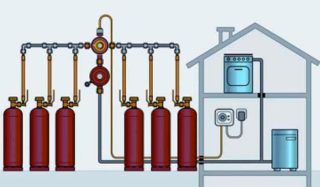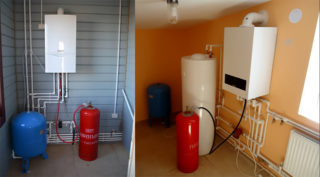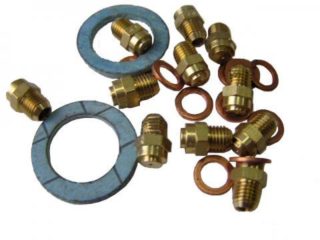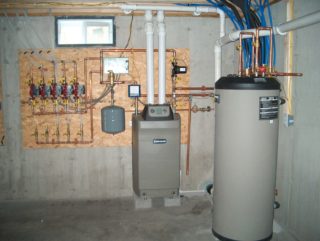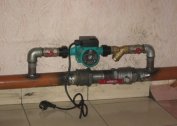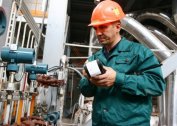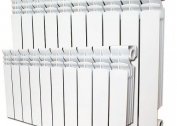A typical gas boiler for liquefied gas for heating a private house is a classic unit that works by burning fuel and turning it into heat. In order to correctly choose and independently install the boiler, you will need to deal with its device and principle of operation. In addition, it is useful for the user to get acquainted with its advantages and disadvantages.
General description and principle of operation
Liquefied gas boilers are energy converters in which a certain type of fuel is transformed into heat going to heat the coolant. The peculiarity of liquefied gas (LHG) is that it cannot be fed to the injection burner in its original form, since the jets are not designed for this. If you do not spray fuel into the smallest drops, it will cause overheating of the equipment and its subsequent destruction upon combustion.
The boiler has nozzles of a smaller diameter and a special gearbox for controlling pressure. Due to its sharp drop at the outlet of the cylinder, the fuel passes into a gaseous form. In this state, it enters directly into the combustion chamber. The specified set of equipment is ordered with the boiler, but can be purchased separately. On some models, a replacement kit is standard. For the rest, the gas boiler operating from bottled gas is completely identical to traditional units.
Types of propane boilers
The classic propane boiler is available in several versions. By the features of the design and organization of the heating process, the units are:
- single-circuit;
- double-circuit;
- convection and condensation.
The functionality of the device and the purpose for which the generated heat is used depends on the number of loops. Single-circuit boilers are intended only for heating rooms, and their double-circuit counterparts allow you to additionally organize hot water supply (DHW).
The efficiency of gas units operating on LPG is largely determined by how the energy released after combustion is used. This can happen in the following ways:
- Convection, in which the coolant is heated due to the energy of direct combustion of the fuel. With this method, part of the generated heat is lost - it is removed along with the exhaust gases.
- Condensation, in which additional heat is extracted in the system due to cooling of the smoke and condensation of the vapor released in the low-temperature heat exchanger.
The condensation type of boilers is considered to be very economical, since during its operation it is possible to reduce fuel consumption by 15-20 percent. However, such a unit costs 1.5-2 times more expensive than a conventional boiler.
Types of boilers by location
According to the method of placement, the boiler equipment is divided into floor and wall units. The difference between them is clearly visible when examining the design. Wall-mounted models are assembled in a small and lightweight housing and are equipped with a steel or copper heat exchanger. In addition, they have more developed functionality.
Floor boilers are not limited by weight and dimensions and often have a cast-iron heat exchanger. In addition, they have an extended range of operating powers (10-60 kW).The difference between these samples is manifested in the configuration presented by the manufacturer.
The set of wall units includes an automatic machine, a circulation pump and a number of other volatile devices. In fact, it is a miniature thermal station ready for operation. Floor boilers do not have developed functionality, but many of the samples are independent of the source of electricity.
Advantages and disadvantages
The advantages of boilers operating on liquefied gas include:
- autonomy - independence from gas pipelines;
- universality - the possibility of conversion to natural gas;
- environmental cleanliness - liquefied fuel does not generate waste when burned;
- simplicity of design and the possibility of independent maintenance and repair.
The negative side of the choice of these products is the increase in operating costs associated with the delivery of fuel from the gas station. To this is added the increased fire hazard and the need for strict observance of the rules for storing combustible compositions.
Users of heating boilers for LPG must constantly monitor the remaining fuel in the attached cylinder. This is due to inconvenience, forcing to update its contents or immediately pump the right amount of gas into the storage.
Criterias of choice
When choosing a boiler suitable for specific conditions, the following points should be considered:
- due to the significant consumption of liquid fuel, it is more reasonable to choose a single-circuit gas unit;
- if it is necessary to equip a separate DHW circuit, it is more convenient to connect an “indirect” boiler to it;
- dual-circuit models are selected in a situation where there are available funds for this.
The most important criterion for choosing the right sample is the correct selection of fuel for it, a payment for which should be provided for years to come. To this are added the costs of arranging the structure inside the house and creating the conditions necessary to maintain a normal temperature.
Rating of popular models and manufacturers
Siberia boilers manufactured at a Russian company are in the lead. These non-volatile units are equipped with a reliable automation system and are fully adapted to the operating conditions. They are made from time-tested, high-quality materials. The assortment on the market is distinguished by the breadth and variety of models.
High-quality and competitively competitive equipment is supplied to Russia by the Italian company Ferroli. Products presented by this company are distinguished by the following features:
- stylish, quite modern design;
- User-friendly and user-friendly panel that displays general operating modes and key indicators;
- compact copper heat exchanger manufactured by the company's patented technology.
The exchange unit is made in the form of 3 copper tubes connected in series in a single design.
The well-known German corporation Bosch is represented by turbocharged convection-type units for wall mounting. They work well in various operating modes and provide the room with heat even at low pressure in the system. The electronic control unit is equipped with a temperature limiter to prevent overheating of the heat exchanger, as well as a pressure sensor that performs a blocking function in the absence of a coolant.
Equally functional and reliable liquefied gas boilers are offered by the Viessmann group of companies from Germany. The range of models includes both floor-mounted samples of high power and mounted units with small dimensions.
